Creatine phosphate
Synonym(s):Creatine phosphate disodium salt tetrahydrate;Sodium creatine phosphate dibasic tetrahydrate
- CAS NO.:67-07-2
- Empirical Formula: C4H10N3O5P
- Molecular Weight: 211.11
- MDL number: MFCD00152044
- EINECS: 200-643-9
- SAFETY DATA SHEET (SDS)
- Update Date: 2024-12-18 14:08:52

What is Creatine phosphate?
The Uses of Creatine phosphate
Phosphocreatine used in the synthesis of hydroxypatite nanorod/nanosheets. Phosphocreatine is used in the treatment of heart and brain ischemia.
Definition
ChEBI: N-phosphocreatine is a phosphoamino acid consisting of creatine having a phospho group attached at the primary nitrogen of the guanidino group. It has a role as a human metabolite and a mouse metabolite. It is a phosphoamino acid and a phosphagen. It is functionally related to a creatine. It is a conjugate acid of a N-phosphocreatinate(2-).
Enzyme inhibitor
This phosphagen (FW = 211.11 g/mol; CAS 67-07-2; 922-32-7 for disodium salt), known almost as commonly as creatine phosphate, is the primary cytosolic phosphoryl donor for the resynthesis of MgATP from MgADP through the action of creatine kinase in vertebrates and some invertebrates. While abundant in skeletal and cardiac muscle (40-60 mM), nonmuscle cells contain 3-5 mM, and some fungi (e.g., Candida) have intermediate levels of this metabolite. Note: The reported inhibitory action by creatine kinase is often due to impurities (e.g., the inhibition of 5’- nucleotidase is due to an impurity in the commercial phosphocreatine). The reported inhibition of AMP deaminase is due mainly to the presence of pyrophosphate. Phosphocreatine is a hygroscopic solid and very soluble in water. Unstable in acid, all is hydrolyzed after one minute at 100°C in 1.0 M HCl, and half is hydrolyzed in 4 min at 25°C in 0.5 M HCl. Molybdate and certain buffers reportedly accelerate hydrolysis. Hydrolysis is slow under slightly alkaline conditions (e.g., pH 7.8). Nevertheless, solutions should always be freshly prepared and stored frozen. Target(s): adenylate cyclase; AMP deaminase; glutamine synthetase; H+-extrusion by plasma membrane ATPase; NADH peroxidase; phosphofructokinase; and thiamin-phosphate diphosphorylase.
Properties of Creatine phosphate
| Melting point: | >175oC (dec.) |
| Boiling point: | 449.1±47.0 °C(Predicted) |
| Density | 1.83±0.1 g/cm3(Predicted) |
| storage temp. | Hygroscopic, -20°C Freezer, Under inert atmosphere |
| solubility | Water |
| form | Solid |
| pka | pKa 4.7± 0.01(H2O,t =25)(Approximate) |
| color | White to Off-White |
| Stability: | Hygroscopic |
| CAS DataBase Reference | 67-07-2(CAS DataBase Reference) |
| EPA Substance Registry System | Glycine, N-[imino(phosphonoamino)methyl]-N-methyl- (67-07-2) |
Safety information for Creatine phosphate
| Signal word | Warning |
| Pictogram(s) |
 Exclamation Mark Irritant GHS07 |
| GHS Hazard Statements |
H315:Skin corrosion/irritation H319:Serious eye damage/eye irritation H335:Specific target organ toxicity, single exposure;Respiratory tract irritation |
| Precautionary Statement Codes |
P261:Avoid breathing dust/fume/gas/mist/vapours/spray. P305+P351+P338:IF IN EYES: Rinse cautiously with water for several minutes. Remove contact lenses, if present and easy to do. Continuerinsing. |
Computed Descriptors for Creatine phosphate
New Products
Methyl (R)-1-Boc-4,4-difluoropyrrolidine-2-carboxylate 2,2-Difluoropropylamine hydrochloride tert-butyl 3-bromoazetidine-1-carboxylate (R)-1-Boc-3-hydroxypyrrolidine DIFLUOROACETIC ANHYDRIDE 2,2-Difluoropropionic acid Diallylamine, 99% Calcium hydroxide, 95% Aluminum oxide, basic 2-Bromophenylacetonitrile, 97% L-tert-Leucine,97% N-Hydroxy-2-methylpropanimidamide 4-(3,4-Dichlorophenyl)-3,4-Dihydro-N-Methyl-1-(2H)-Naphthalenimine (Schiff Base) 2-AMINO-3,5-DIBROMO BENZALDEHYDE [ADBA] L-Glutamic Acid Dimethyl Ester Hcl 10-Methoxy-5H-dibenz[b,f]azepine 5-Cyanophthalide N, N-Carbonyldiimidazole (CDI) Dibenzoyl Peroxide Titanium Dioxide 2-(Methylthio) Benzonitrile Sodium Acetate Anhydrous Allopurinol 1,5-DibromopentaneRelated products of tetrahydrofuran








You may like
-
 Creatine phosphate 92% CAS 67-07-2View Details
Creatine phosphate 92% CAS 67-07-2View Details
67-07-2 -
![Cis-2-(Bromomethyl)-2-(2,4-Dichlorophenyl)-1,3-Dioxolane-4-Ylmethyl Benzoate [CBB] 61397-56-6 99%](https://img.chemicalbook.in//Content/image/CP5.jpg) Cis-2-(Bromomethyl)-2-(2,4-Dichlorophenyl)-1,3-Dioxolane-4-Ylmethyl Benzoate [CBB] 61397-56-6 99%View Details
Cis-2-(Bromomethyl)-2-(2,4-Dichlorophenyl)-1,3-Dioxolane-4-Ylmethyl Benzoate [CBB] 61397-56-6 99%View Details
61397-56-6 -
 287930-77-2 / 142569-70-8 99%View Details
287930-77-2 / 142569-70-8 99%View Details
287930-77-2 / 142569-70-8 -
 Ethyl-2-Chloroacetoacetate 609-15-4View Details
Ethyl-2-Chloroacetoacetate 609-15-4View Details
609-15-4 -
 CIS- BROMO BENZOATEView Details
CIS- BROMO BENZOATEView Details
61397-56-6 -
 609-15-4View Details
609-15-4View Details
609-15-4 -
![1-(6-Methylpyridin-3-Yl)-2-[4-(Methylsulfonyl)Phenyl]Ethanone [Ketosulfone] 99%](https://img.chemicalbook.in//Content/image/CP5.jpg) 1-(6-Methylpyridin-3-Yl)-2-[4-(Methylsulfonyl)Phenyl]Ethanone [Ketosulfone] 99%View Details
1-(6-Methylpyridin-3-Yl)-2-[4-(Methylsulfonyl)Phenyl]Ethanone [Ketosulfone] 99%View Details
221615-75-4 -
 27143-07-3View Details
27143-07-3View Details
27143-07-3
